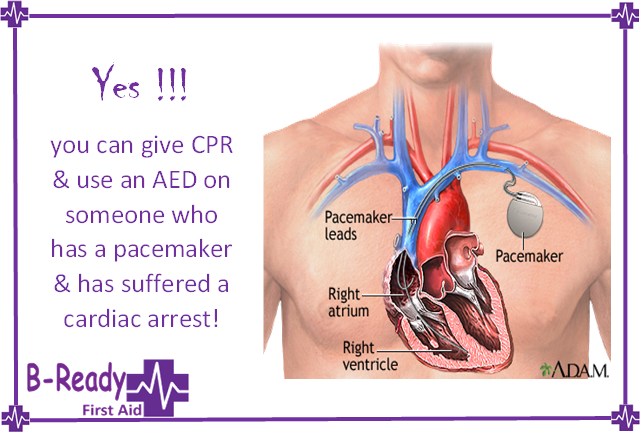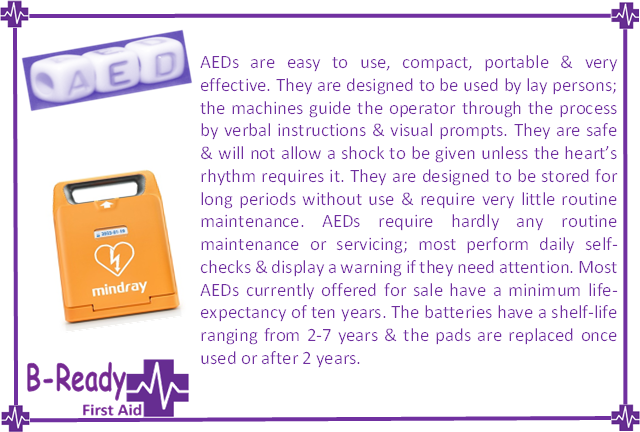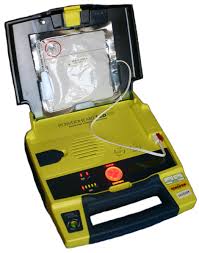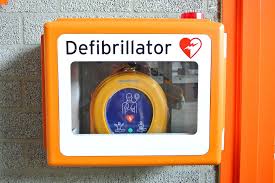B-The one to make a difference learn CPR, First Aid, Asthma & Anaphylaxis Management with B-Ready First Aid in Brisbane, 2 Locations Camira/Springfield,
& Gatton.
Refresh on topics below!
& Gatton.
Refresh on topics below!
These AED are the one's which we think are great value for money as well as an easy-to-use reliable unit.
|
Just a few pointers about upkeep for a Defibrillator if you own one!
|
For all casualties who are unresponsive & not breathing normally, chest compressions should be commenced immediately & continued until an AED is applied. The AED should be applied as soon as it becomes available so that a shock can be delivered if necessary.
|
|
|
If a casualty with a stoma requires CPR you can use a key-ring, one way valve device over the stoma but remember to block the nose & mouth when breathing for them.
30 - 2 no matter who!
30 - 2 no matter who!
Do you know where the closest defibrillator to home is? What about where you are on the weekend or at work ? Have a look around and note where they are!
The AIMS of the ARC
1. foster and co-ordinate the practice and teaching of resuscitation.
2. promote uniformity and standardization of resuscitation techniques.
3. act as a voluntary coordinating body.
1. foster and co-ordinate the practice and teaching of resuscitation.
2. promote uniformity and standardization of resuscitation techniques.
3. act as a voluntary coordinating body.
|
All rescuers should perform chest compressions for all persons who are unresponsive and not breathing normally
Rescuers should perform chest compressions for all ages at a rate of 100 to 120 compressions per minute (almost 2 compressions/second) B-The one to make a difference B-Trained & B-Ready |
Strategically placed AED don't you think??
Keep your eyes on the lookout! |
|
The purpose of CPR is to temporarily maintain a circulation sufficient to preserve brain function until specialized treatment is available.
|
AED use should not be restricted to trained personnel. Allowing the use of AEDs by individuals without prior formal training can be beneficial & may be lifesaving. ☎️ ➡️ 🚑 ➡️ 🏥
|
This is pretty amazing but does not replace the initial CPR by a bystander.
|
Two hands for adult CPR, 30 compressions (100-120 per min) & 2 breaths if possible. Any Attempt is better than none!
|
CPR for a child aged approx 1-8 years of age we would use one hand, possibly with support, as seen here. 30 compression's -2 breaths (if possible) @ a rate of approx 100-120 compressions per minute.
|
|
How to give Infant CPR, use a firm surface underneath the child, press with two fingers or your thumbs on the lower part of the sternum. 30 compressions and followed by two little puffs without tilting their head back. Keep going until there are signs of normal breathing returning or until help arrives.
|
What are your thoughts on this? Interesting idea! The Gift of LIFE.
|
CPR History short videos and information!
|
Check out the early days & beginnings of CPR! Some interesting events have happened to get to where we are today!
This is the third in the series of how CPR has progressed and this is the more recent years that some of you may relate to if you have been taking your First Aid courses. Many changes happen and improve outcomes for many people.
|
Amazing how things have been learnt over the years. Here is some interesting progress that I'm grateful for.
Last in the series of how CPR has changed over recent history including the use of the Defibrillator and the change of 30 compression's and 2 breaths for all casualties.
|
|
With the increase of locations for everyone to access an AED (Automated External Defibrillator) here is an example of one, they are similar but not all exactly the same. B-The one to make a difference B-Trained with B-Ready First Aid
|
We often get asked about these types of Tattoos, so here is some information. However, unless you are using a defibrillator or they were swimming we generally would not remove clothing to notice.
|
|
There are a few apps around that can make a game out of learning this for kids, browse your app store and see which would B-Best & B-Ready in an emergency!
|
CPR is best with 100-120 beats per minute, this is the ideal rate, pressing down approx 1/3 the depth of their chest on the lower half of the sternum. Not too low or they might vomit or regurgitate. Yes, you can break ribs or even have other injuries but this is deemed reasonable consequences!
|
|
B-Ready First Aid... A glimpse into the past history of CPR and some amazing discoveries over the years... In Australia we also include two breaths with the 30 compressions unlike America and other countries that have hands only CPR!
|
B-Ready First Aid ...A Life saved mouth to mouth by a co-worker... He lived until 2002
|
|
B-Ready First Aid.. Every Minute counts
|
B-Ready First Aid, CPR Myth 1
|
|
B-Ready First Aid, More Aussies needed to learn CPR
|
B-Ready learn CPR Way to go Scotland, Same same all around the world!
|
|
B-Ready CPR 30 Compression & 2 Breaths
|
Ever wondered about the CPR Manikin face?
|
|
A little of CPR history of techniques, shaping things to come! Worth the time!
|
CPR Flash mob in America. Educating will save lives
|
|
|
|
B-Ready to make a difference, B-Trained in CPR and First Aid Today.
Below is part one and two of an amazing rescue from years ago, Please be advised that part one could be confronting especially to those who have never seen real CPR with Defibrillation and in a Drowning setting.
Viewers discretion is advised.
Viewers discretion is advised.
|
|
|
|
|
|
We Would Love to Have You train with us!
HoursOffice hours
M-Th: 9am - 5pm F: 9am-4pm |
Telephone |
|

























































